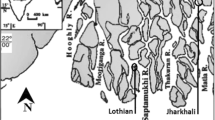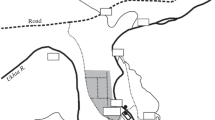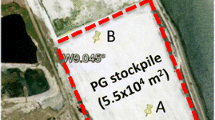Abstract
The distribution of 14 rare earth elements, Th and U was studied in streams of the study area at 21 sites. Aquatic mosses are known to accumulate even metabolically nonessential or toxic metals in concentrations much higher than their aqueous environment due to their unique morphology and physiology. Thus, the capacity of metal amplification in four aquatic mosses (Fontinalis squamosa, Brachythecium rivulare, Platyhypnidium riparioides and Thamnobryum alopecurum) was also evaluated as a potential bioindicator/biomonitoring tool. Thirteen REEs (0.001–2.81 μg L−1) and U were detected in the stream water. Mean content of lighter rare earth elements (LREEs) was higher than that of heavier rare earth elements (HREEs). Fourteen REEs and two actinides were detected in moss samples, including Yb and Th which were below detection level in water samples. LREE uptake (0.17–12.2 mg kg−1) was greater than HREE uptake (0.02–0.78 mg kg−1) in all mosses. Uptake of LREEs was observed in the order: B. rivulare >T. alopecurum >F. squamosa >P. riparioides and that of HREEs in the order: T. alopecurum >B. rivulare >F. squamosa >P. riparioides. Mean U content (0.68–1.62 mg kg−1) in the mosses was found in the order: B. rivulare >F. squamosa >T. alopecurum >P. riparioides. Th content ranged from 0.4 to 2.36 mg kg−1 in the order: B. rivulare >T. alopecurum >P. riparioides >F. squamosa. One-way ANOVA indicated a statistically significant difference (P ≤ 0.01) in mean concentrations of all elements (individually) in moss samples except for U. Highest bioconcentration factors of six REEs each were observed in B. rivulare (La, Ce, Sm, Eu, Tb and Dy) and T. alopecurum (Nd, Gd, Ho, Er, Tm and Lu). The highest BCFs for Pr and U were obtained in F. squamosa and P. riparioides, respectively. These species hold promise for biomonitoring studies in the future.


Similar content being viewed by others
References
Agnan Y, Séjalon-Delmas N, Probst A (2014) Origin and distribution of rare earth elements in various lichen and moss species over the last century in France. Sci Total Environ 487:1–12
Barry MJ, Meehan BJ (2000) The acute and chronic toxicity of lanthanum to Daphnia carinata. Chemosphere 41:1669–1674
Berg T, Steinnes E (1997) Recent trends in atmospheric deposition of trace elements in Norway as evident from the 1995 moss survey. Sci Total Environ 208:197
Blaise C, Gagne F, Ferard JF, Eullaffroy P (2008) Ecotoxicity of selected nano-materials to aquatic organisms. Environ Toxicol 23:591–598
Cenci RM (2000) The use of aquatic moss (Fontinalis antipyretica) as monitor of contamination in standing and running waters: Limits and advantages. J Limnol 60(1):53–61
Chiarenzelli J, Aspler L, Dunn C, Cousens B, Ozarko D, Powis K (2001) Multi-element and rare earth element composition of lichens, mosses, and vascular plants from the Central Barrenlands, Nunavut, Canada. Appl Geochem 16(2):245–270
Davranche M, Gruau G, Dia A, Marsac R, Pédrot M, Pourret O (2015) Biogeochemical factors affecting rare earth element distribution in shallow wetland groundwater. Aquat Geochem 21:197–215
Debén S, Aboal JR, Carballeira A, Cesa M, Real C, Fernández JA (2015) Inland water quality monitoring with native bryophytes: a methodological review. Ecol Indic 53:115–124
Demon A, De Bruin M, Wolterbeek HT (1989) The influence of pre-treatment, temperature and calcium ions on trace element uptake by an alga (Scenedesmus pannonicus, subsp. Berlin) and fungus (Aureobasidium pullulans). Environ Monitor Assess 13:21–33
EDM (2014) Empresa de Desenvolvimento Mineiro, SA – Escádia Grande–Góis Project (in Portuguese). http://www.edm.pt/html/escadiagrande.htm. Accessed on 8 December 2016
Favas P, Pratas J, Varun M, D’Souza R, Paul M (2013) Accumulation of uranium by aquatic plants in field conditions: potential for phytotechnologies. Sci Total Environ 470–47IC:993–1002
Feio MJ, Aguiar FC, Almeida SFP, Ferreira MT (2012) Aquaflora: a predictive model based on diatoms and macrophytes for streams water quality assessment. Ecol Indic 18:586–598
Figueira R, Ribeiro T (2005) Transplants of aquatic mosses as biomonitors of metals released by a mine effluent. Environ Pollut 136:293–301
Fouquet Y, Martel-Jantin B (2014) Rare and strategic metals. In: Fouquet Y, Lacroix D (eds) Deep Marine Mineral Resources. Springer Netherlands, pp 55–64
Gaiser BK, Fernandes TF, Jepson M, Lead JR, Tyler CR, Stone V (2009) Assessing exposure, uptake and toxicity of silver and cerium dioxide nanoparticles from contaminated environments. Environ Health 8(Suppl 1):S2
Gecheva G, Yurukova L (2014) Water pollutant monitoring with aquatic bryophytes: a review. Environ Chem Lett 12:49–61
Gecheva G, Yurukova L, Cesac M, Cheshmedjiev S (2013) Monitoring of aquatic mosses and sediments: a case study in contaminated rivers, Bulgaria. Plant Biosysts 149(3):527–536
Gerdol R, Bragazza L, Marchesini R, Alber R, Bonetti L, Lorenzoni G, Achilli M, Buffoni A, De Marco N, Franchi M, Pison S, Giaquinta S, Palmieri F, Spezzanto P (2000) Monitoring of heavy metal deposition in Northern Italy by moss analysis. Environ Pollut 108:201–208
Hatch GP (2012) Dynamics in the global market for rare earths. Elements 8:341–346
Kabata-Pendias A (2011) Trace elements in soils and plants. CRC Press, Boca Raton
Kano N (2013) Biosorption of lanthanides using select marine biomass. In: Matovic MD, (eds), Biomass now—sustainable growth and use, ISBN: 978-953-51-1105-4, InTech, doi: 10.5772/51164
Kapfer J, Audorff V, Beierkuhnlein C, Hertel E (2012) Do bryophytes show a stronger response than vascular plants to interannual changes in spring water quality? Freshw Sci 31:625–635
Kifle D, Sverdrup H, Koca D, Wibetoe G (2013) A simple assessment of the global long term supply of the rare earth elements by using a system dynamics model. Environ Nat Resour Res 3:77. doi:10.5539/enrr.v3n1p77
Kučera J, Mizera J, Řanda Z, Vávrová M (2007) Pollution of agricultural crops with lanthanides, thorium and uranium studied by instrumental and radiochemical neutron activation analysis. J Radioanal Nucl Chem 271(3):581–587
Lai Y, Wang Q, Yang L, Huang B (2006) Subcellular distribution of rare earth elements and characterization of their binding species in a newly discovered hyperaccumulator Pronephrium simplex. Talanta 70:26–31
Lansdown R, Bosanquet S (2010) Riverine plants as biological indicators. In: Hurford C, Schneider M, Cowx I (eds) Conservation monitoring in freshwater habitats: a practical guide and case studies. Springer, Dordrecht, pp 73–83
Laul JC, Weimer WC, Rancitelli LA (1979) Biogeochemical distribution of rare earths and other trace elements in plants and soils. In: Ahrens LH (ed) Origin and distribution of the elements, vol 11. Pergamon Press, Oxford, p 819
Laville N, Ait-Aissa S, Gomez E, Casellas C, Porcher JM (2004) Effects of human pharmaceuticals on cytotoxicity, EROD activity and ROS production in fish hepatocytes. Toxicology 196:41–55
Lewis LH, Jiménez-Villacorta F (2013) Perspectives on permanent magnetic materials for energy conversion and power generation. Metallur Mater Trans A 44:2–20
Liang T, Li K, Wang L (2014) State of rare earth elements in different environmental components in mining areas of China. Environ Monit Assess 186:1499–1513
López J, Carballeira A (1993) Interspecific differences in metal bioaccumulation and plant-water concentration ratios in five aquatic bryophytes. Hydrobiologia 263:95–107
Lürling M, Tolman Y (2010) Effects of lanthanum and lanthanum-modified clay on growth, survival and reproduction of Daphnia magna. Water Res 44:309–319
Markert B (1987) The pattern of distribution of lanthanide elements in soils and plants. Phytochemistry 26:3167–3170
Meireles C, Sequeira AJD, Castro P, Ferreira N (2013) New data on the lithostratigraphy of Beiras Group (Schist Greywacke Complex) in the region of GóisArganil-Pampilhosa da Serra (Central Portugal). Cadernos Lab Xeolóxico de Laxe Coruña 37:105–124
Mohanty K, Jha M, Meikap BC, Biswas MN (2006) Biosorption of lanthanides using three kinds of seaweed biomasses. Chem Eng J 117:71–77
Moss RL, Tzimas E, Kara H, Willis P, Kooroshy J (2013) The potential risks from metals bottlenecks to the deployment of strategic energy technologies. Energy Policy 55:556–564
Nakamura Y, Tsumura Y, Shibata T, Ito Y (1997) Differences in behavior among the chlorides of seven rare earth elements administered intravenously to rats. Fundam Appl Toxicol 37:106–116
Navarro J, Zhao F (2014) Life-cycle assessment of the production of rare-earth elements for energy applications: a review. Front Energy Res 2:1–17
Oliveira JMS (1990) Geological, mineralogical and lithogeochemical studies in the Gois and Vila Pouca de Aguiar-Vila Real region, Portugal. Estud Notas e Trab 32:65–75
Palasz A, Czekaj P (2000) Toxicological and cytophysiological aspects of lanthanides action. Acta Biochim Pol 47(4):1107–1114
Palmieri HEL, Hermínio NA, Kurt F (2007) Distribution of rare earths, thorium and uranium in bryophytes and soils in Tripuí ecological station, Minas Gerais, Brazil. In: International nuclear atlantic conference - INAC 2007; Santos, SP, Brazil, September 30 to October 5, 2007. ASSOCIAÇÃO BRASILEIRA DE ENERGIA NUCLEAR – ABEN; ISBN: 978-85-99141-02-1
Parra AAHN (1990) Resultados da aplicação do método mineralométrico com base em solos superficiais à prospecção de jazidas primárias de cassiterite, volframite e ouro na região de Góis. Estud Notas e Trab 32:83–92
Pirc S (2003) Aquatic mosses as sampling medium in geochemistry. RMZ-Mater. Geoenviron 50(4):735–763
Pothen F (2014) Dynamic market power in an exhaustible resource industry: the case of rare earth elements. ZEW Discussion Papers, No. 14-005. Mannheim
Pratas J, Paulo JCF, Paulo C, Rodrigues N, Prasad MNV (2012) Uranium accumulation by aquatic plants from uranium-contaminated water in Central Portugal. Int J Phytorem 14:221–234
Raju KK, Raju AN (2000) Biogeochemical investigation in south eastern Andhra Pradesh: the distribution of rare earths, thorium and uranium in plants and soils. Environ Geology 39(10):1102–1106
Reimann C, Caritat P (1998) Chemical elements in the environment: factsheets for the geochemist and environmental scientist. Springer, Berlin, p 398
Ruhling A, Tyler G (2004) Changes in the atmospheric deposition of minor and rare elements between 1975 and 2000 in south Sweden, as measured by moss analysis. Environ Pollut 131:417–423
Ruhling A, Rasmussen L, Pilegaard K, Makinen A, Steinnes E (1987) Survey of atmospheric heavy metal deposition in Nordic countries in 1985. Report for Nordic Council of Ministers, Kobenhavn
Samecka-Cymerman A, Kempers AJ (1992) Anomalous elemental composition of aquatic bryophytes near barite zones in the Sowie Mts. (Poland). J Geochem Explor 43:213–221
Samecka-Cymerman A, Kempers AJ (1993) Scapania undulata (L.) Dum. and other aquatic bryophytes as indicators of mineralization in Poland. J Geochem Explor 46:325–334
Schöner A, Noubactep C, Büchel G, Sauter M (2009) Geochemistry of natural wetlands in former uranium milling sites (eastern Germany) and implications for uranium retention. Chem Erde-Geochem 69:91–107
Sert S, Kutahyali C, Inan S, Talip Z, Cetinkaya B, Eral M (2008) Biosorption of lanthanum and cerium from aqueous solutions by Platanus orientalis leaf powder. Hydrometallurgy 90:13–18
Shan XQ, Wang HO, Zhang SZ, Zhou HF, Zheng Y, Yu H, Wen B (2003) Accumulation and uptake of light rare earth elements in a hyperaccumulator Dicropteris dichotoma. Plant Sci 165:1343–1353
Slooff W, Bont PFH, Van den Hoop, MAGT, Janus JA, Annema JA (1993) Exploratory report rare earth elements and their compounds. Report No. RIVM 710401025, National Institute of Public Health and the Environment, Bilthoven, The Netherlands
Sneller FEC, Kalf DF, Weltje L, Van Wezel AP (2000) Maximum Permissible Concentrations and Negligible Concentrations for Rare Earth Elements (REEs). Report No. RIVM 601501011, National Institute of Public Health and the Environment, Bilthoven
Sonich-Mullin C (2013) Rare earth elements: a review of production, processing, recycling, and associated environmental issues. Office of Research and Development, EPA/600/R-12/572, 135 p, USA
Spencer A, Wilson S, Batchelor J, Reid A, Rees J, Harpur E (1997) Gadolinium chloride standing and running waters: limits and advantages. J Limnol 60(Suppl. 1):53–61
Stanley JK, Byrne RH (1990) The influence of solution chemistry on REE uptake by Ulva lactuca L. in seawater. Geochim Cosmochim Acta 54:1587–1595
Tagami K, Uchida S (2006) Transfer of REEs from nutrient solution to radish through fine roots and their distribution in the plant. J Alloys Compd 408:409–412
Tremp H, Kampmann D, Schulz R (2012) Factors shaping submerged bryophyte communities: a conceptual model for small mountain streams in Germany. Limnol Ecol Manage Inland Waters 42:242–250
Vanderpoorten A, Goffinet B (2009) Introduction to bryophytes. Cambridge University Press, Cambridge
Vázquez MD, Wappelhorst O, Markert B (2004) Determination of 28 elements in aquatic moss Fontinalis antipyretica Hedw. and water from the upper reaches of the river Nysa (CZ, D), by ICPMS, ICP-OES and AAS. Water Air Soil Pollut 152:153–172
Vieira C, Aguiar FC, Ferreira MT (2014) The relevance of bryophytes in the macrophyte-based reference conditions in Portuguese rivers. Hydrobiologia 737:245–264
Watson-Leung T (2009) Phoslock Toxicity Testing with Three Sediment Dwelling Organisms (Hyalella azteca, Hexagenia spp. and Chironomus dilutus) and Two Water Column Dwelling Organism (Rainbow Trout and Daphnia magna), Aquatic Toxicology Unit, Laboratory Services Branch, Ontario Ministry of the Environment Etobicoke
Wehr JD, Whitton BA (1983) Accumulation of heavy metals by aquatic mosses. Rhynchostegium riparioides. Hydrobiologia 100:261–284
Weltje L (2002) Bioavailability of lanthanides to freshwater organisms. Speciation, accumulation and toxicity, Thesis, Interfaculty Reactor Institute, Delft University of Technology, The Netherlands
Weltje F. (2002) Bioavailability of Lanthanides to Freshwater Organisms. Speciation, Accumulation and Toxicity, Thesis, Interfaculty Reactor Institute, Delft University of Technology, Netherland
Whitton BA (2003) Use of plants for monitoring heavy metals in freshwaters. In: Ambasht RS, Ambasht NK (eds) Modern trends in applied aquatic ecology. Kluwer Academic/Plenum Publishers, New York, pp 43–63
Yang XJ, Lin A, Li XL, Wu Y, Zhou W, Chen Z (2013) China’s ion-adsorption rare earth resources, mining consequences and preservation. Environ Dev 8:131–136
Yliruokanen I (1975) Uranium, thorium, lead, lanthanides and yttrium in some plants growing on granite and radioactive rocks. Bull Geol Soc Fin 49:71–78
Zechmeister HG, Grodzinka KG, Szarek-Lukaszewka, (2003) Bryophytes. In: Markert B, Breure AM, Zechmeister HG (eds) Bioindicators and biomonitors. Elsevier Science Ltd, Amsterdam, p 104
Zhang H, Feng J, Zhu WF, Liu CQ, Xu SQ, Shao PP, Wu S, Yang WJ, Gu JH (2000) Chronic toxicity of rare-earth elements in human beings: implications of bloos biochemical indices in REE-high regions, South Jiang Xi. Biol Trace Elem Res 73(1):1–17
Acknowledgements
This study had the support of Fundação para a Ciência e Tecnologia (FCT), through the strategic project UID/MAR/04292/2013 granted to MARE. We especially thank Inês Silva for assisting in moss identification. The authors are grateful to the anonymous reviewers for critically examining the matter and also for their valuable and constructive comments and suggestions, which have considerably improved the quality of the manuscript.
Author information
Authors and Affiliations
Corresponding author
Electronic supplementary material
Below is the link to the electronic supplementary material.
Rights and permissions
About this article
Cite this article
Pratas, J., Favas, P.J.C., Varun, M. et al. Distribution of rare earth elements, thorium and uranium in streams and aquatic mosses of Central Portugal. Environ Earth Sci 76, 156 (2017). https://doi.org/10.1007/s12665-017-6459-2
Received:
Accepted:
Published:
DOI: https://doi.org/10.1007/s12665-017-6459-2




